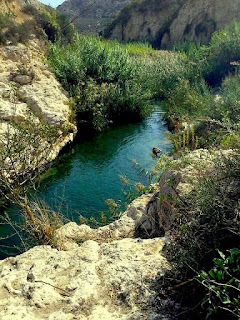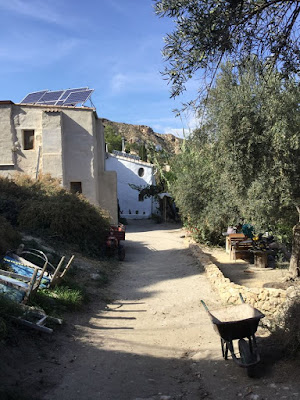The off-grid village Los Molinos del Río Aguas in Andalucia is a little miracle, an oasis of biodiversity in the middle of a rocky desert : its valley appears dry and inauspicious from above but becomes more green and lush as we reach the river bed.

Photos © Analucia Feracci
Thanks to the Rio Aguas that runs through the Tabernas sub desert (considered the most arid region of Europe), here the valley transforms into an oasis of trees, cactus and agaves, making it a unique observational platform for eco-alternative futures.

Photo © Analucia Feracci
With its unexpected forest of Eucalyptus, Silver birches and White poplars and its river bed of Pampas grass and Reeds, this part of the valley stands out from the rocky surroundings, visually affirming that Water is Life, that water is sacred.
Thanks to an irrigation and sewage system dating back to the roman ages, the village that nests in the valley is also blooming with Pomagranates, Lemon and Fig trees, while the river contributes to maintain a vibrant fauna and flora, hosting endemic flower species and freshwater spur-thighed tortoises, species that don't exist anywhere else.
 |
| Photo © Ion Holban |
The presence of underwater storage helps the valley to flourish : that water springs from within the Gypsum Kart rock formations as it was pointed out to me by environmental activist Jorge Blanco Abad.

The water is then redistributed via an ingenious pumping system, an hearty device that supplies for the village needs so that vegetable gardens can survive desertification.



Photos © Analucia Feracci
Today, an intensive culture of millions of genetically modified olive trees grown in plain Tabernas desert is pilling the water of this Aguas Aquifer, draining underground water - a method of extraction considered has mining as it extracts fossil water.
As this water is the only local source to the whole area and this agro-industry requires an impressive amount of water, the plantation is simply stealing water from the local population.
As Jorge Blanco Abad pointed out, we can observe this phenomenon in the river : where water lines have left their marks, the rocks stand as witness of the lowering of water levels (in 2014, the water flow in the cave springs dropped from 70 liters per seconds to 15 liters, leading to desertification).

Photo © Ion Holban
That flow disorder didn't happen because of the drought but comes from the springs. This desertification not only endangers species, killing plants and animals, but also threatens the livelihood of local communities, forcing people to migrate.
This is not news as the village of Los Molinos was falling into ruins following previous displacement of population, it is still being restored by the new locals.
The link between water levels and the massive plantation of olive trees, as well as the future of local communities is also well explained in the following video by environmental activist David Dene.
 |
As he told me at his home in Los Molinos, the desertification process has already happened so there is no time left : the oasis is simply disappearing !
Fortunately, the case of the Aguas Aquifer which has been denounced by experts of hydro-geology at Almeria University is now considered as Ecocide.

Nos Roban el Agua © Design by Daniel Torrego for Sunseed Desert Technology
It will be taken before the International Tribunal for the Rights of Nature at the Bonn COP23 International Summit on the 7th of November 2017 by La Plataforma en Defensa del Rio Aguas y Acuiferos Vivos.
So what should we wish for ?
An intensive plantation of genetically modified olive trees ?
Or water for the plants, the animals and the inhabitants of this oasis ?
A desert with no water ?
Or an oasis with water ?
Poderosos grupos inversores, en connivencia con las Administraciones, han plantado millones de olivos en regadío en pleno desierto de Tabernas, Almería. Estos monocultivos superintensivos son regados con aguas fósiles extraídas del Acuífero Aguas, el más sobre-explotado de toda Andalucía (400%), y del que depende el Río Aguas, uno de los pocos recursos hídricos de la provincia, completamente desertificada.
La grave situación ya está originando problemas de abastecimiento en los núcleos urbanos y aldeas de la zona. Todos los estudios coinciden en que el río se secará completamente en los próximos años, sentenciando a muerte a la flora y la fauna, muchas de ellas especies endémicas, poniendo en peligro los modos de vida sostenibles de la comarca, condenando a sus 35.000 habitantes a la migración precaria y acabando con el Paraje Natural Karst en Yesos de Sorbas.
Recientemente, el canal de televisión europeo "ARTE" y la televisión suiza han proyectado una serie de documentales al respecto. La comunidad internacional se ha hecho eco de la situación y el caso ha sido incluido en el Tribunal por los Derechos de la Naturaleza COP23, para ser juzgado en la ciudad alemana de Bonn el próximo 7 de noviembre.
Dado que la Junta de Andalucía y el Gobierno central se niegan a actuar, hemos decidido salir a la calle para apoyar a nuestras enviadas a Bonn.
Exigimos la revisión y limitación de las concesiones de agua, así como la realización de un estudio hídrico en condiciones.
Convocan: Plataforma en Defensa Del Acuífero del Río de Aguas y Acuíferos Vivos






















No comments:
Post a Comment